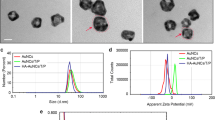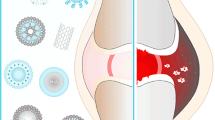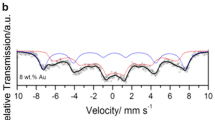Abstract
Objective
Nanoparticles (NPs) hold a great promise in combating rheumatoid arthritis, but are often compromised by their toxicities because the currently used NPs are usually synthesized by chemical methods. Our group has previously fabricated Ångstrom-scale silver particles (AgÅPs) and demonstrated the anti-tumor and anti-sepsis efficacy of fructose-coated AgÅPs (F-AgÅPs). This study aimed to uncover the efficacy and mechanisms of F-AgÅPs for arthritis therapy.
Methods
We evaluated the efficacy of F-AgÅPs in collagen-induced arthritis (CIA) mice. We also compared the capacities of F-AgÅPs, the commercial AgNPs, and the clinical drug methotrexate (MTX) in protecting against K/BxN serum-transfer arthritis (STA) mice. Moreover, we evaluated the effects of F-AgÅPs and AgNPs on inflammation, osteoclast formation, synoviocytes migration, and matrix metalloproteinases (MMPs) production in vitro and in vivo. Meanwhile, the toxicities of F-AgÅPs and AgNPs in vitro and in vivo were also tested.
Results
F-AgÅPs significantly prevented bone erosion, synovitis, and cartilage damage, attenuated rheumatic pain, and improved the impaired motor function in mouse models of CIA or STA, the anti-rheumatic effects of which were comparable or stronger than AgNPs and MTX. Further studies revealed that F-AgÅPs exhibited similar or greater inhibitory abilities than AgNPs to suppress inflammation, osteoclast formation, synoviocytes migration, and MMPs production. No obvious toxicities were observed in vitro and in vivo after F-AgÅPs treatment.
Conclusions
F-AgÅPs can effectively alleviate arthritis without notable toxicities and their anti-arthritic effects are associated with the inhibition of inflammation, osteoclastogenesis, synoviocytes migration, and MMPs production. Our study suggests the prospect of F-AgÅPs as an efficient and low-toxicity agent for arthritis therapy.









Similar content being viewed by others
Data availability
All data generated or analyzed during this study are included in this published article.
Abbreviations
- RA:
-
Rheumatoid arthritis
- AgÅPs:
-
Ångstrom-scale silver particles
- F-AgÅPs:
-
Fructose-coated AgÅPs
- NSAIDs:
-
Non-steroidal anti-inflammatory drugs
- SAARDs:
-
Slow-acting anti-rheumatic drugs
- NPs:
-
Nanoparticles
- AgNPs:
-
Nanometer-scale silver particles
- CIA:
-
Collagen-induced arthritis
- MTX:
-
Methotrexate
- STA:
-
K/BxN serum-transfer arthritis
- MMP:
-
Matrix metalloproteinase
- DAB:
-
Diaminobenzidine tetrahydrochloride
- BMMs:
-
Primary murine bone marrow macrophages
- FBS:
-
Fetal bovine serum
- M‐CSF:
-
Recombinant murine macrophage colony‐stimulating factor
- PS:
-
Penicillin–streptomycin
- SD:
-
Standard deviation
- ANOVA:
-
Analysis of variance
References
Smolen JS, Aletaha D, McInnes IB. Rheumatoid arthritis. Lancet. 2016;388:2023–38.
Muller-Ladner U, Pap T, Gay RE, Neidhart M, Gay S. Mechanisms of disease: the molecular and cellular basis of joint destruction in rheumatoid arthritis. Nat Clin Pract Rheumatol. 2005;1:102–10.
Rheumatoid arthritis. Nat Rev Dis Primers. 2018; 4: 18002.
Corrado A, Rotondo C, Mele A, Cici D, Maruotti N, Sanpaolo E, et al. Influence of glucocorticoid treatment on trabecular bone score and bone remodeling regulators in early rheumatoid arthritis. Arthritis Res Ther. 2021;23:180.
Smolen JS, Steiner G. Therapeutic strategies for rheumatoid arthritis. Nat Rev Drug Discov. 2003;2:473–88.
Zhang S, Wu L, Cao J, Wang K, Ge Y, Ma W, et al. Effect of magnetic nanoparticles size on rheumatoid arthritis targeting and photothermal therapy. Colloids Surf B Biointerfaces. 2018;170:224–32.
Jeong M, Park JH. Nanomedicine for the treatment of rheumatoid arthritis. Mol Pharm. 2021;18:539–49.
Avalos A, Haza AI, Mateo D, Morales P. Cytotoxicity and ROS production of manufactured silver nanoparticles of different sizes in hepatoma and leukemia cells. J Appl Toxicol. 2014;34:413–23.
Miethling-Graff R, Rumpker R, Richter M, Verano-Braga T, Kjeldsen F, Brewer J, et al. Exposure to silver nanoparticles induces size- and dose-dependent oxidative stress and cytotoxicity in human colon carcinoma cells. Toxicol In Vitro. 2014;28:1280–9.
Wang ZX, Chen CY, Wang Y, Li FXZ, Huang J, Luo ZW, et al. Ångstrom-scale silver particles as a promising agent for low-toxicity broad-spectrum potent anticancer therapy. Adv Funct Mater. 2019;29:1808556.
Kuang X, Wang Z, Luo Z, He Z, Liang L, Gao Q, et al. Ag nanoparticles enhance immune checkpoint blockade efficacy by promoting of immune surveillance in melanoma. J Colloid Interface Sci. 2022;616:189–200.
Deng YQ, Wang ZX, Liu X, Wang YY, Chen Q, Li ZL, et al. Angstrom-scale silver particles potently combat SARS-CoV-2 infection by suppressing the ACE2 expression and inflammatory responses. J Mater Chem B. 2022;10:5454–64.
Li YY, Xia K, Liu YW, Tan YJ, Li HM, Wang YY, et al. Fructose-coated angstrom silver particles suppress gastric cancer growth by activating gasdermin D-mediated pyroptosis. Adv Ther. 2023;6:2200100.
Hu XK, Rao SS, Tan YJ, Yin H, Luo MJ, Wang ZX, et al. Fructose-coated angstrom silver inhibits osteosarcoma growth and metastasis via promoting ROS-dependent apoptosis through the alteration of glucose metabolism by inhibiting PDK. Theranostics. 2020;10:7710–29.
Yin H, Zhou M, Chen X, Wan TF, Jin L, Rao SS, et al. Fructose-coated angstrom silver prevents sepsis by killing bacteria and attenuating bacterial toxin-induced injuries. Theranostics. 2021;11:8152–71.
Chen CY, Yin H, Chen X, Chen TH, Liu HM, Rao SS, et al. Ångstrom-scale silver particle-embedded carbomer gel promotes wound healing by inhibiting bacterial colonization and inflammation. Sci Adv. 2020;6:eaba0942.
Brand DD, Latham KA, Rosloniec EF. Collagen-induced arthritis. Nat Protoc. 2007;2:1269–75.
Monach PA, Mathis D, Benoist C. The K/BxN arthritis model. Curr Protoc Immunol. 2008. https://doi.org/10.1002/0471142735.im1522s81.
Liu R, Chen Y, Fu W, Wang S, Cui Y, Zhao X, et al. Fexofenadine inhibits TNF signaling through targeting to cytosolic phospholipase A2 and is therapeutic against inflammatory arthritis. Ann Rheum Dis. 2019;78:1524–35.
Jin Y, Liu Q, Chen P, Zhao S, Jiang W, Wang F, et al. A novel prostaglandin E receptor 4 (EP4) small molecule antagonist induces articular cartilage regeneration. Cell Discov. 2022;8:24.
Hu X, Liu Y, Wu J, Liu Y, Liu W, Chen J, et al. Inhibition of P2X7R in the amygdala ameliorates symptoms of neuropathic pain after spared nerve injury in rats. Brain Behav Immun. 2020;88:507–14.
Wei K, Korsunsky I, Marshall JL, Gao A, Watts GFM, Major T, et al. Notch signalling drives synovial fibroblast identity and arthritis pathology. Nature. 2020;582:259–64.
Levescot A, Chang MH, Schnell J, Nelson-Maney N, Yan J, Martinez-Bonet M, et al. IL-1beta-driven osteoclastogenic tregs accelerate bone erosion in arthritis. J Clin Invest. 2021. https://doi.org/10.1172/JCI141008.
Fatima F, Fei Y, Ali A, Mohammad M, Erlandsson MC, Bokarewa MI, et al. Radiological features of experimental staphylococcal septic arthritis by micro computed tomography scan. PLoS ONE. 2017;12: e0171222.
Liu ZZ, Hong CG, Hu WB, Chen ML, Duan R, Li HM, et al. Autophagy receptor OPTN (optineurin) regulates mesenchymal stem cell fate and bone-fat balance during aging by clearing FABP3. Autophagy. 2021;17:2766–82.
Auréal M, Machuca-Gayet I, Coury F. Rheumatoid arthritis in the view of osteoimmunology. Biomolecules. 2020;11:48.
Lefèvre S, Knedla A, Tennie C, Kampmann A, Wunrau C, Dinser R, et al. Synovial fibroblasts spread rheumatoid arthritis to unaffected joints. Nat Med. 2009;15:1414–20.
Burrage PS, Mix KS, Brinckerhoff CE. Matrix metalloproteinases: role in arthritis. Front Biosci. 2006;11:529–43.
Wang D, Zhang J, Lau J, Wang S, Taneja V, Matteson EL, et al. Mechanisms of lung disease development in rheumatoid arthritis. Nat Rev Rheumatol. 2019;15:581–96.
Kalashnikova I, Chung SJ, Nafiujjaman M, Hill ML, Siziba ME, Contag CH, et al. Ceria-based nanotheranostic agent for rheumatoid arthritis. Theranostics. 2020;10:11863–80.
Wu H, He Y, Wu H, Zhou M, Xu Z, Xiong R, et al. Near-infrared fluorescence imaging-guided focused ultrasound-mediated therapy against rheumatoid arthritis by MTX-ICG-loaded iRGD-modified echogenic liposomes. Theranostics. 2020;10:10092–105.
Li Y, Liang Q, Zhou L, Cao Y, Yang J, Li J, et al. An ROS-responsive artesunate prodrug nanosystem co-delivers dexamethasone for rheumatoid arthritis treatment through the HIF-1alpha/NF-kappaB cascade regulation of ROS scavenging and macrophage repolarization. Acta Biomater. 2022;152:406–24.
Han Y, Wang J, Li S, Li Y, Zhang Y, Zhang R, et al. Isopsoralen ameliorates rheumatoid arthritis by targeting MIF. Arthritis Res Ther. 2021;23:243.
Park JS, Yang SC, Jeong HY, Lee SY, Ryu JG, Choi JW, et al. EC-18 prevents autoimmune arthritis by suppressing inflammatory cytokines and osteoclastogenesis. Arthritis Res Ther. 2022;24:254.
Zhai Z, Yang F, Xu W, Han J, Luo G, Li Y, et al. Attenuation of rheumatoid arthritis through the inhibition of tumor necrosis factor-induced caspase 3/gasdermin E-mediated pyroptosis. Arthritis Rheumatol. 2022;74:427–40.
Fukui S, Gutch S, Fukui S, Cherpokova D, Aymonnier K, Sheehy CE, et al. The prominent role of hematopoietic peptidyl arginine deiminase 4 in arthritis: collagen- and granulocyte colony-stimulating factor-induced arthritis model in C57BL/6 mice. Arthritis Rheumatol. 2022;74:1139–46.
Zhang M, Hu W, Cai C, Wu Y, Li J, Dong S. Advanced application of stimuli-responsive drug delivery system for inflammatory arthritis treatment. Mater Today Bio. 2022;14: 100223.
Li C, Zheng X, Hu M, Jia M, Jin R, Nie Y. Recent progress in therapeutic strategies and biomimetic nanomedicines for rheumatoid arthritis treatment. Expert Opin Drug Deliv. 2022;19:883–98.
Mohammadinejad R, Moosavi MA, Tavakol S, Vardar DO, Hosseini A, Rahmati M, et al. Necrotic, apoptotic and autophagic cell fates triggered by nanoparticles. Autophagy. 2019;15:4–33.
Means N, Elechalawar CK, Chen WR, Bhattacharya R, Mukherjee P. Revealing macropinocytosis using nanoparticles. Mol Aspects Med. 2022;83: 100993.
Zeng C, Feng Y, Wang W, Zhou F, Liao F, Liu Y, et al. The size-dependent apoptotic effect of titanium dioxide nanoparticles on endothelial cells by the intracellular pathway. Environ Toxicol. 2018;33:1221–8.
Guo X, Wu Z, Li W, Wang Z, Li Q, Kong F, et al. Appropriate size of magnetic nanoparticles for various bioapplications in cancer diagnostics and therapy. ACS Appl Mater Interfaces. 2016;8:3092–106.
Park MV, Neigh AM, Vermeulen JP, de la Fonteyne LJ, Verharen HW, Briede JJ, et al. The effect of particle size on the cytotoxicity, inflammation, developmental toxicity and genotoxicity of silver nanoparticles. Biomaterials. 2011;32:9810–7.
Liu Y, Wang Z, Liu Y, Zhu G, Jacobson O, Fu X, et al. Suppressing nanoparticle-mononuclear phagocyte system interactions of two-dimensional gold nanorings for improved tumor accumulation and photothermal ablation of tumors. ACS Nano. 2017;11:10539–48.
Tsoi KM, MacParland SA, Ma XZ, Spetzler VN, Echeverri J, Ouyang B, et al. Mechanism of hard-nanomaterial clearance by the liver. Nat Mater. 2016;15:1212–21.
Acknowledgements
This work was supported by the Special Funding for the Construction of Innovative Provinces in Hunan (Grant Nos. 2019SK2301), the Science and Technology Innovation Program of Hunan Province (Grant Nos. 2022RC1211), the China National Postdoctoral Program for Innovative Talents (Grant Nos. BX2021383), the Central South University Innovation-Driven Research Programme (Grant Nos. 2023CXQD001), the Hunan Province Natural Science Foundation of China (Grant No. 2023JJ10094), and the Hunan Provincial Innovation Foundation for Postgraduate (Grant Nos. 2021zzts0342, 2022ZZTS0239). We especially thank Professor Fu-Bin Li (Shanghai Jiao Tong University) for providing T cell receptor (TCR)-transgenic KRN mice.
Author information
Authors and Affiliations
Contributions
HX, C-YC, and Z-HH designed this study. Z-HH and C-YC wrote the manuscript. Z-HH, J-TZ, XC, J-SG, YC, LJ, Y-WL, WD, H-ML, Y-XQ, Y-YW, T-FW, HZ, and YL, did the experiments or/and analyzed the data. Z-HH and C-YC prepared the figures. S-SR, YH, Y-JT, Z-XW, and ZW provided technical support. All authors read and approved the manuscript.
Corresponding authors
Ethics declarations
Conflict of interest
No conflict of interest.
Ethics approval
All animal experiments in this study were approved by the Ethical Review Board at Xiangya Hospital of Central South University (no. 202009015). Animal care and all experimental procedures were conducted in accordance with the Department of Laboratory Animals of Central South University.
Consent to publish
Not applicable.
Consent to participate
Not applicable.
Additional information
Responsible Editor: Jason J. McDougall.
Publisher's Note
Springer Nature remains neutral with regard to jurisdictional claims in published maps and institutional affiliations.
Supplementary Information
Below is the link to the electronic supplementary material.
Rights and permissions
Springer Nature or its licensor (e.g. a society or other partner) holds exclusive rights to this article under a publishing agreement with the author(s) or other rightsholder(s); author self-archiving of the accepted manuscript version of this article is solely governed by the terms of such publishing agreement and applicable law.
About this article
Cite this article
He, ZH., Zou, JT., Chen, X. et al. Ångstrom-scale silver particles ameliorate collagen-induced and K/BxN-transfer arthritis in mice via the suppression of inflammation and osteoclastogenesis. Inflamm. Res. 72, 2053–2072 (2023). https://doi.org/10.1007/s00011-023-01778-0
Received:
Revised:
Accepted:
Published:
Issue Date:
DOI: https://doi.org/10.1007/s00011-023-01778-0




